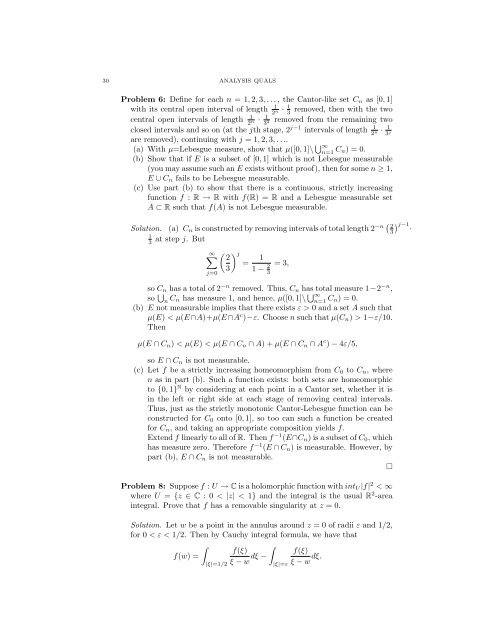ANALYSIS QUALIFYING EXAM PROBLEMS BRIAN LEARY ...
ANALYSIS QUALIFYING EXAM PROBLEMS BRIAN LEARY ...
ANALYSIS QUALIFYING EXAM PROBLEMS BRIAN LEARY ...
Create successful ePaper yourself
Turn your PDF publications into a flip-book with our unique Google optimized e-Paper software.
30 <strong>ANALYSIS</strong> QUALS<br />
Problem 6: Define for each n = 1, 2, 3, . . . , the Cantor-like set Cn as [0, 1]<br />
with its central open interval of length 1<br />
2n · 1<br />
3 removed, then with the two<br />
central open intervals of length 1<br />
2n · 1<br />
32 removed from the remaining two<br />
closed intervals and so on (at the jth stage, 2j−1 intervals of length 1<br />
2n · 1<br />
3j are removed), continuing with j = 1, 2, 3, . . ..<br />
(a) With µ=Lebesgue measure, show that µ([0, 1]\ ∞<br />
n=1 Cn) = 0.<br />
(b) Show that if E is a subset of [0, 1] which is not Lebesgue measurable<br />
(you may assume such an E exists without proof), then for some n ≥ 1,<br />
E ∪ Cn fails to be Lebesgue measurable.<br />
(c) Use part (b) to show that there is a continuous, strictly increasing<br />
function f : R → R with f(R) = R and a Lebesgue measurable set<br />
A ⊂ R such that f(A) is not Lebesgue measurable.<br />
Solution. (a) Cn is constructed by removing intervals of total length 2−n 2<br />
3<br />
at step j. But<br />
1<br />
3<br />
∞<br />
j=0<br />
j 2<br />
=<br />
3<br />
1<br />
1 − 2<br />
3<br />
= 3,<br />
so Cn has a total of 2 −n removed. Thus, Cn has total measure 1−2 −n ,<br />
so <br />
n Cn has measure 1, and hence, µ([0, 1]\ ∞ n=1 Cn) = 0.<br />
(b) E not measurable implies that there exists ε > 0 and a set A such that<br />
µ(E) < µ(E∩A)+µ(E∩A c )−ε. Choose n such that µ(Cn) > 1−ε/10.<br />
Then<br />
µ(E ∩ Cn) < µ(E) < µ(E ∩ Cn ∩ A) + µ(E ∩ Cn ∩ A c ) − 4ε/5,<br />
so E ∩ Cn is not measurable.<br />
(c) Let f be a strictly increasing homeomorphism from C0 to Cn, where<br />
n as in part (b). Such a function exists: both sets are homeomorphic<br />
to {0, 1} N by considering at each point in a Cantor set, whether it is<br />
in the left or right side at each stage of removing central intervals.<br />
Thus, just as the strictly monotonic Cantor-Lebesgue function can be<br />
constructed for C0 onto [0, 1], so too can such a function be created<br />
for Cn, and taking an appropriate composition yields f.<br />
Extend f linearly to all of R. Then f −1 (E∩Cn) is a subset of C0, which<br />
has measure zero. Therefore f −1 (E ∩ Cn) is measurable. However, by<br />
part (b), E ∩ Cn is not measurable.<br />
<br />
Problem 8: Suppose f : U → C is a holomorphic function with intU |f| 2 < ∞<br />
where U = {z ∈ C : 0 < |z| < 1} and the integral is the usual R 2 -area<br />
integral. Prove that f has a removable singularity at z = 0.<br />
Solution. Let w be a point in the annulus around z = 0 of radii ε and 1/2,<br />
for 0 < ε < 1/2. Then by Cauchy integral formula, we have that<br />
<br />
<br />
f(ξ)<br />
f(ξ)<br />
f(w) =<br />
dξ −<br />
ξ − w ξ − w dξ.<br />
|ξ|=1/2<br />
|ξ|=ε<br />
j−1·
















